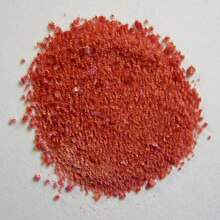Cobalt(II) sulfate

| |
| Names | |
|---|---|
| IUPAC name
Cobalt(II) sulfate
| |
| Identifiers | |
3D model (JSmol)
|
|
| ChEBI | |
| ChemSpider | |
| ECHA InfoCard | 100.030.291 |
| EC Number |
|
PubChem CID
|
|
| RTECS number |
|
| UNII | |
CompTox Dashboard (EPA)
|
|
| |
| |
| Properties | |
| CoSO4 | |
| Molar mass | 154.996 g/mol (anhydrous) 173.01 g/mol (monohydrate) 263.08 g/mol (hexahydrate) 281.103 g/mol (heptahydrate) |
| Appearance | reddish crystalline (anhydrous, monohydrate) pink salt (heptahydrate) |
| Odor | odorless (heptahydrate) |
| Density | 3.71 g/cm3 (anhydrous) 3.075 g/cm3 (monohydrate) 2.019 g/cm3 (hexahydrate) 1.948 g/cm3 (heptahydrate) |
| Melting point | 735 °C (anhydrous) 96.8 °C (heptahydrate) |
| Boiling point | 420 °C (heptahydrate) |
| anhydrous: 36.2 g/100 mL (20 °C) 38.3 g/100 mL (25 °C) 84 g/100 mL (100 °C) heptahydrate: 60.4 g/100 mL (3 °C) 67 g/100 mL (70 °C) | |
| Solubility | anhydrous: 1.04 g/100 mL (methanol, 18 °C) insoluble in ammonia heptahydrate: 54.5 g/100 mL (methanol, 18 °C) |
Refractive index (nD)
|
1.639 (monohydrate) 1.540 (hexahydrate) 1.483 (heptahydrate) |
| Structure | |
| orthorhombic (anhydrous) monoclinic (monohydrate, heptahydrate) | |
| Hazards | |
| NFPA 704 (fire diamond) | |
| Flash point | Non-flammable |
| Lethal dose or concentration (LD, LC): | |
LD50 (median dose)
|
424 mg/kg (oral, rat) |
Except where otherwise noted, data are given for materials in their standard state (at 25 °C [77 °F], 100 kPa).
| |
Cobalt(II) sulfate is the inorganic compound with the formula CoSO4. It is the divalent cobalt salt of sulfuric acid. The most common form of cobalt sulfate are the hydrates CoSO4.7H2O and CoSO4.H2O. Cobalt(II) sulfate and its hydrates are some of the most commonly available salts of cobalt.
Properties
Cobalt(II) sulfate appears as red monoclinic crystals that melt around 100 °C and become anhydrous at 250 °C. It is soluble in water, slightly soluble in ethanol, and especially soluble in methanol. It forms by the reaction of metallic cobalt, its oxide, hydroxide, or carbonate with sulfuric acid. Cobalt is obtained from ores via the sulfate in some cases.[1][2]
Uses
Cobalt(II) sulfate is used in the preparation of pigments, as well as in the manufacture of other cobalt salts. Cobalt pigment is used in porcelains and glass. Cobalt(II) sulfate is used in storage batteries and electroplating baths, sympathetic inks, and as an additive to soils and animal feeds. For these purposes, the cobalt sulfate is produced by treating cobalt oxide with sulfuric acid.[1]
Health issues
Cobalt is essential for most higher forms of life, but more than a few milligrams each day is harmful. Rarely have poisonings resulted from cobalt compounds. Upon inhalation of salts, there is some evidence for carcinogenicity.[1]
References
- ^ a b c John D. Donaldson, Detmar Beyersmann "Cobalt and Cobalt Compounds" in Ullmann's Encyclopedia of Industrial Chemistry 2005, Wiley-VCH, Weinheim. doi:10.1002/14356007.a07_281.pub2
- ^ Rarely, cobalt(II) sulfate is found in form of few crystallohydrate minerals, occurring among oxidation zones containing primary Co minerals (like skutterudite or cobaltite). These minerals are: biebierite (heptahydrate), moorhouseite (Co,Ni,Mn)SO4.6H2O, aplowite (Co,Mn,Ni)SO4.4H2O and cobaltkieserite (monohydrate).

